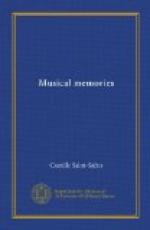“Everyone ought to make his own rules. Music is free and unlimited in its liberty of expression. There are no perfect chords, dissonant chords or false chords. All aggregations of notes are legitimate.”
That is called, and they believe it, the development of taste.
He whose taste is developed by this system is not like the man who by tasting a wine can tell you its age and its vineyard, but he is rather like the fellow who with perfect indifference gulps down good or bad wine, brandy or whiskey, and prefers that which burns his gullet the most. The man who gets his work hung in the Salon is not the one who puts on his canvas delicate touches in harmonious tones, but he who juxtaposes vermillion and Veronese green. The man with a “developed taste” is not the one who knows how to get new and unexpected results by passing from one key to another, as the great Richard did in Die Meistersinger, but rather the man who abandons all keys and piles up dissonances which he neither introduces nor concludes and who, as a result, grunts his way through music as a pig through a flower garden.
Possibly they may go farther still. There seems to be no reason why they should linger on the way to untrammeled freedom or restrict themselves within a scale. The boundless empire of sound is at their disposal and let them profit by it. That is what dogs do when they bay at the moon, cats when they meow, and the birds when they sing. A German has written a book to prove that the birds sing false. Of course he is wrong for they do not sing false. If they did, their song would not sound agreeable to us. They sing outside of scales and it is delightful, but that is not man-made art.
Some Spanish singers give a similar impression, through singing interminable grace notes beyond notation. Their art is intermediate between the singing of the birds and of man. It is not a higher art.
In certain quarters they marvel at the progress made in the last thirty years. The architects of the Fifteenth Century must have reasoned in the same way. They did not appreciate that they were assassinating Gothic art, and that after some centuries we would have to revert to the art of the Greeks and Romans.
CHAPTER X
THE ORGAN
When hairy Pan joined reeds of different lengths and so invented the flute which bears his name, he was, in reality, creating the organ. It needed only to add to this flute a keyboard and bellows to make one of those pretty instruments the first painters used to put in the hands of angels. As it developed and gradually became the most grandiose of the instruments, the organ, with its depth of tone modified and increased tenfold by the resonance of the great cathedrals, took on its religious character.
The organ is more than a single instrument. It is an orchestra, a collection of the pipes of Pan of every size, from those as small as a child’s playthings to those as gigantic as the columns of a temple. Each one corresponds to what is termed an organ-stop. The number is unlimited.




